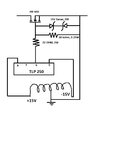shomikc
Member level 4
Hello all,
I am using the following Gate Driver for IRF 640 MOSFET.
My Optocoupler TLP 250 keeps getting destroyed.

I don't know what I am doing wrong but it seems that high current is being drawn.
The transformer supplies power top the optocoupler through voltage regulators 7815 and 7915.
Any help on shedding a little light on my problem will be much appreciated.
Thanks.
I am using the following Gate Driver for IRF 640 MOSFET.
My Optocoupler TLP 250 keeps getting destroyed.

I don't know what I am doing wrong but it seems that high current is being drawn.
The transformer supplies power top the optocoupler through voltage regulators 7815 and 7915.
Any help on shedding a little light on my problem will be much appreciated.
Thanks.
